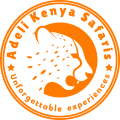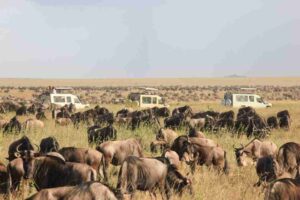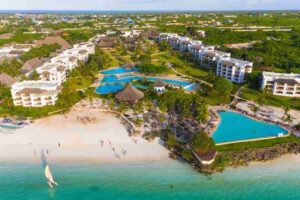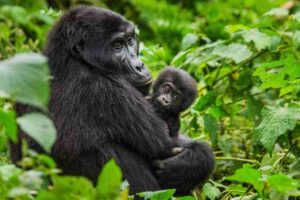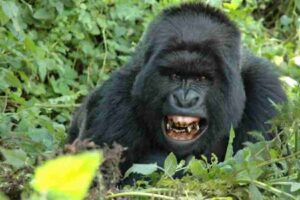| Name of the facility | Sala’s Camp |
|---|---|
| Certification Achieved | Gold |
| Year opened | 2006 |
| Tourism region | Masai Mara/South Rift |
| County | Narok |
| Address | Head Office – Nairobi Map It |
| Telephone/Mobile | +254725675830 |
| info@thesafaricollection.com | |
| Website | thesafaricollection.com |
| Facility Notes | Sala’s Camp is located within Masai Mara National Reserve close to the confluence of the Sand and Keekorok Rivers. It was opened in 2006 operated by The Safari Collection. It has nine (9) guest tents with a bed capacity of 18 guests and a total work force of 32 employees for its operations. The facility is architecturally designed to have low environmental impact. The guest tents are made of canvas raised on sand and gravel. The staff quarters are designed of grey, green and beige fly-tents pitched on the ground. Low impact activities including nature walks, bird watching and village visits are offered. The Maasai Mara National Reserve covers approximately 1,510 km2 under the management of Narok County. The Reserve is located in the northern portion of the Mara Serengeti eco-system, which covers 25,000 km2 straddling Tanzania and Kenya. Serengeti Park borders the Reserve to the south, Siria (or Oloololo) Escarpment in the west and community-owned conservancies to the North and East of the reserve. The Reserve has about 95 species of mammals and 570 species of birds recorded. It is famous for hosting the wildebeest migration, which is dubbed as the ‘8th Wonder of the World’. The migration occurs from the months of July to September. It involves wildebeests, Thomson’s gazelles, Topi, elands, and zebras. These migrants are followed along their annual, circular route by predators, most notably lions and hyenas. Numerous other antelopes can be found, including Thomson’s and Grant’s gazelles, impalas, duikers and Coke’s hartebeest. The Mara is also home to the “Big Five” (lion, leopard, African elephant, African buffalo, and Black Rhinoceros). The plains are also home to the distinctive Masai giraffe. |
| Energy management | Sala’s camp is primarily run on solar power. The camp has three solar water heaters. Water heating for 4 guest tents, the manager tent and two of the guide tents is done using efficient kuni boilers. Fuel wood for the boilers is sustainably sourced from a private farm in Naivasha. The camp has a backup generator with an output of 41.5KVA In order to promote energy conservation, the camp has LED (Light Emitting Diodes) and energy saving bulbs fixed throughout Visitors are briefed upon arrival on the need to conserve energy through switching off unnecessary lights. Liquefied Petroleum Gas (LPG) is used for guest and staff cooking. Laundry done within the camp is air dried to minimize on energy consumption that would have otherwise been used. |
| Environmental management | Sala’s Camp is anchored on sustainable management Policy on promoting environmental and community wellbeing in its surrounding. The policy is committed to: Compliance with relevant environmental legislation and proactive approach to future requirements. Monitoring performance for continued improvement in environmental performance Conservation of natural resources through responsible use of water, energy and other resources.The facility has a clear environmental management system (EMS) with elaborate management plans in waste water, water and energy use, solid waste management and health and safety. The camp has undertaken its annual self-Environmental Audit (EA) as required by EMCA 1999 (Environmental Management and Co-ordination Act.) |
| Chemical use | The camp uses Diversy chemicals for cleaning the kitchen and laundry. Material Safety Data Sheet (MSDS) for the chemicals used within the camp are available. The staff handling chemicals has been trained and is sensitized on proper handling. Petrol is stored in metal jerry cans in a secured structure. Diesel for use in the generator and vehicle is bought in bulk and stored in a 2 tonne tank that is properly secured in a bunded structure. |
| Conservation Criteria | |
| Community Criteria | |
| Solid waste management | Proper waste separation – organic and non-organic – is conducted at source. The waste is further segregated at the waste management centre into plastics, glass and metallic tins. Monitoring of the waste is later done through weighing and recording (types and quantity) before disposal. Disposal of the waste is done through Takataka solutions. Organic waste is composted at secured pit, to prevent interference from wildlife. |
| Water management | The main source of water is a borehole located within the camp. The water is stored in a reservoir of 15,000 litres. The water is metered at source. Water meter readings are taken on a weekly basis and analysed on bed occupancy to monitor usage. To promote water efficiency; Employees are sensitized on water usage during departmental meetings Guests are sensitized on arrival briefings. Guests are also encouraged and sensitized through cards – ‘towel talks’ to re-use their towels. The guests’ rooms are fixed with dual flush toilet cisterns, and low shower filter heads for water use efficiency. The guest tents have buckets that are used to collect cold shower water before hot water runs in the shower. This water is collected by housekeeping staff and used for cleaning. Water taps within the premises are also fixed with faucets (flow reducers) to enhance water conservation. Visual water saving sensitization signage is fixed within the main water user points such as kitchen and laundry. |
| Visitor communication & education | Guest rooms are sufficiently equipped with information on the activities of Sala’s Camp and the other Safari Collection properties. The information ranges from community projects to conservation activities of the properties. The guest information folders in the tents also have information on flora and fauna of the Masai Mara and the greater East Africa Region. Visitors are also briefed about the camp briefed upon arrival. |
| Pollution | The generator operation hours are closely monitored for servicing purposes. The generator is insulated and to reduce on sound pollution. The paths ways are illuminated with lanterns at night to reduce on light pollution. |
| Environmental conservation | Sala’s Camp is actively involved in environmental conservation in various ways including: Payment of park fees at the rate of 70 USD per guest Payment of 40 USD per person per night as conservation fee Support of the Rhino Rangers The camp donates 5USD per bed night to the Rhino Rangers Team. The Rhino Rangers is actively involved in the protection and monitoring of rhinos within the Masai Mara. In 2016 the camp donated 4,000 USD from bed night fees. The team also received 30,000 USD from funds raised to support them with new uniforms and monitoring equipment. Biodiversity monitoring: Sala’s Camp has a conservation vehicle that is primarily dedicated to monitoring of biodiversity. The vehicle is used to track cheetah movements and monitor the populations of lions and leopards within the Mara. The conservation vehicle is has recorded about 17,000 km of mileage while conducting monitoring in the Mara. Support for conservation projects: Sala’s Camp supports the Marah Cheetah Project and the Mara Lion Project. The camp specifically supports these projects with data collected by their tour guides as well as fuel for their vehicles. In 2016, the camp donated 5,000 USD towards these projects. In January 2016, Sala’s participated in a Rhino dehorning project, The camp provided logistical support for this project. The camp supports Kenya Wildlife Trust through a fundraising partnership. The Camp fund raises for KWT activities directly through its guests and on the company website. |
| Waste water management | Swimming pool water is cleaned through sieving, vacuum cleaning and a backwash system. PH levels (i.e. acidity and alkalinity levels) are checked on a daily basis. Grey water from the kitchen is passed through portable grease traps before it flows into a soak way. The camp has a clearly outlined drainage plan where grey waste water from the laundry, guest rooms and staff quarters is managed via soak pits. Black water from the facility is managed through a system of septic tanks and soak pits. The Facility has a total of 7 soak pits. Bioclean is added to the tanks on a regular basis to facilitate break down of organic matter. The camp has an effluent discharge license in compliance with NEMA – Environmental Management and Coordination (Water Quality) Regulations of 2006. The facility conducts regular water effluent sampling in compliance with Environmental Management and Coordination (Water Quality) Regulations of 2006 |
| Purchasing and supplies | The camp purchases its products in bulk to reduce on packaging; fruits and vegetables are packed in re-usable crates. |
| Employment and remuneration/staff welfare | Approximately 50% of the permanent employees are from the local community. Additionally, all casual labour is sourced from the locals. Employees are provided with, food, uniform, medical care, and transport. The staff are paid in line with the minimum wage. |
| Staff education, communication and awareness training | The camp has notice boards fitted in strategic sections within the premise. The notice board are used for facilitating communication. Sensitization and briefing is also done on regular meetings via the heads of department. |
| Cultural preservation and promotion/protection of local sites | Sala’s Camp promotes local cultural heritage by engaging the guests in village visits, to the local Sekenani Village. The proceeds from these visits are paid directly to the villagers. |
| Benefits to local community/community empowerment | Sala’s Camp purchases from the locals where possible. Fruits, vegetables and eggs are sourced from local suppliers in Sekenani. The facility has a corporate social responsibility (CSR) program to enhance the community wellbeing. The program majors on education and health. Each community project is tied to increasing conservation awareness and responsibility over natural resources. This is achieved through having nature talks/ films shown during each CSR activity. Some of the CSR activities conducted within the Mara by the Camp over the last two years include; Sports and Social Awareness; Sala’s Camp held a week long Health and leadership training camp at Kakenya Centre for excellence. This is a girls boarding school for under privileged but high achieving girls. This activity saw over 300 girls trained in sports, public speaking, basic hygiene and self-defence. Health; as part of the Safari Collection, Sala’s Camp holds annual health clinics within the Mara region. • In November 2016, the camp held a 5 days dental clinic in different locations that is, Ol Mutia, Nkuas, Talek, Ol Donyo Loldopai and Aitong. Approximately 500 people were treated at the clinic. • In April 2017, the camp held an eye and dental clinic at Ole Mutia and Nkuas ares. The clinic attended to 1400 people in including 50 surgeries. Education; the Camp supports education in the following ways; • Bursaries for secondary school education. These bursaries are secured through fundraising or direct guest donations. In 2016 three female students from the Sasaab community were sponsored to attend secondary boarding schools. This year, the camp has secured one scholarship worth 6000 USD to fund one • The camp has begun completely rebuilding the Honi Primary School outside Solio Lodge. So far they have completed nine classrooms and a staff room. Plans are underway in 2017 to rebuild the dining rooms, kitchens and permaculture gardens. Shop: The gift shop at the camp stocks items from Mara Trust which supports the empowerment of local Masai women. Lease fees: The local community land owners allocated the parcel of land on which the camp is built benefit directly through payment of lease fees. This is paid at the rate of 40 USD per bed night. In 2016, the total amount paid to the land owners was 90,000 USD. Periodic Donations: The camp makes periodic donations to the local community when needed. Recently, the camp contributed to the repair of a section of the road from Sekenani to Mara Bridge. The camp also uses its own vehicle to transport the locals to the health clinics that it hosts. |
| Cultural Criteria | |
| Health and safety | Food handlers have undergone medical tests in compliance with Food, Drugs, and Chemical substances Act. Cap 254 The guest tents are equipped with flash lights, blow horns, and fire extinguishers for emergency and fire safety response. Firefighting equipment which includes fire extinguishers, fire horse rails, automatic fire hydrant system, are serviced and strategically placed within the facility. Fire exits and assembly points are properly marked and displayed within the facility. A fire alarm is also available The hotel has conducted a Health and Safety Audit in compliance with Occupational Safety and Health Act, 2007. The facility has conducted a fire safety audit to comply with Factories and other places of work (Fire Risk Reduction) Rules 2007. Health Inspection has been conducted by public health inspectors under the Ministry of Public Health and Sanitation. The hotel has been issued with a Health Inspection License. |
| Child labor, abuse and human rights | Sala’s Camp has a well-defined Human Resource policy that guides against employment of minors. Minimum employment age is 18years. The camp also has a clearly documented child protection policy. |
| Business Practises Criteria | |
| Entry Date | 10th November 2017 |
